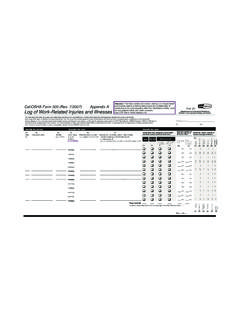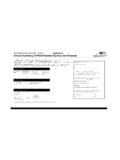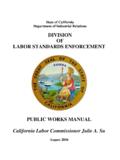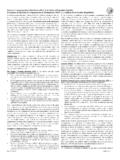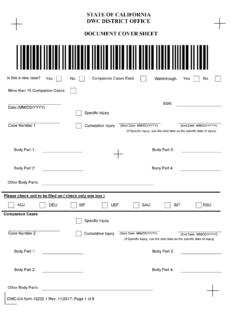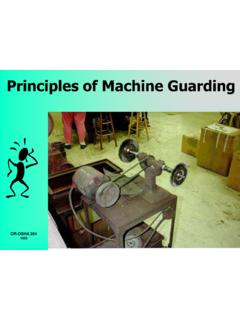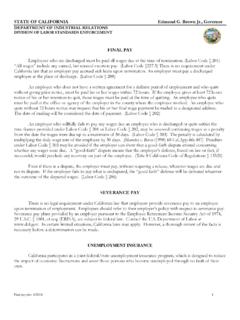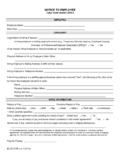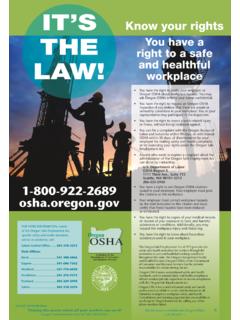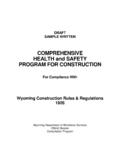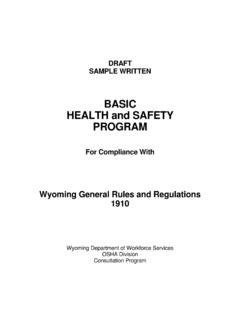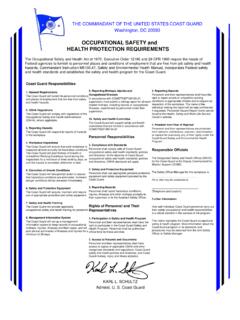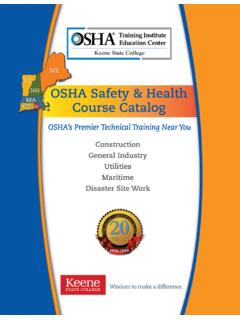Transcription of All workers - California Department of Industrial Relations
1 111 All workershave rightsin CaliforniaDepartment of Industrial RelationsLabor Enforcement Task ForceChristine Baker, DirectorJulie A. Su, Labor CommissionerJuliann Sum, Chief of Cal/OSHAJ anuary 2015 This booklet provides general information and is notmeant to serve as legal advice. It was developed bythe Department of Industrial Relations and its LaborEnforcement Task Force with assistance from theLabor Occupational health Program at UC by Mike KonopackiDesign by Cuttriss and Hambleton Department of Industrial Relations Cal/ osha Christine Baker, Director Juliann Sum, Cal/ osha Chief JUNE 2015 health & safety Rights: Facts for California workers Photo Credits: Bob Gumpert The State of California , Division of Occupational safety and health better known as Cal/ osha is working to assure you have a safe and healthful workplace. Read this fact sheet to understand your basic rights and learn what you can do to help keep your job safe.
2 Employers Program to Prevent Injuries and Illnesses California law requires your employer to have an effective injury and illness prevention program (IIPP) that includes training and instruction on safe work practices and an effec-tive system for your employer to communicate with you and your coworkers. (See page 4 for more information about IIPP requirements.) You should actively participate in the training provided by your employer, learn how to recognize health and safety hazards, and inform your employer about any hazards you discover. Your employer must have a system to encourage reporting hazards without fear of retaliation and must correct hazards in a timely manner. Cal/ osha Enforcement You have the right to file a complaint about a workplace hazard with Cal/ osha , the state agency that investigates and enforces health and safety requirements in California workplaces.
3 If you choose to give your name, Cal/ osha will keep your name confidential, unless you request otherwise. To file a complaint, call the Cal/ osha district office serving the location of your job. To find the right district office, use one of these options: Go online and follow instructions for filing a complaint. Or go to Cal/ osha s home page at , and link to File a workplace safety complaint. View a map showing Cal/ osha district offices and the counties they serve. Or go to Cal/ osha s home page at , link to Locations - Enforcement offices, and then link to map of the Cal/ osha Enforcement regional and district offices. By phone, call 1-866-924-9757, press or say 2 for Cal/ osha , then enter or say the zip code of your job site. Information you should provide to district office staff: When you call Cal/ osha , the information you provide may be critical to the success of Cal/ osha s investigation of the hazard.
4 You should give the staff person the following information: Name and address of your employer. Include the job site address if it is different from the mailing address. Where the hazard is located at the job site. Example: The table saw in room 12. When the hazardous operation or condition occurs. Example: We use this solvent to clean every Friday afternoon. Description of the hazard. You do not need to know the legal requirements. You only need to state the problem. Examples: Bad brakes on forklift, or no fall protection. Investigation Cal/ osha investigates complaints of hazards in different ways. Sometimes, the fastest and most effective way is for Cal/ osha to notify the employer and require the employer to correct the hazard. Other times, Cal/ osha conducts an on-site inspection. On-site inspection When Cal/ osha conducts an on-site inspection, the inspector arrives without advance notice.
5 Upon arrival, the inspector holds an opening conference with the employer and union (if there is one) to explain the purpose of the inspection and how it will be conducted. The inspector walks around the site, observes hazards, interviews employees and supervisors, reviews written records, and takes measurements and photographs as necessary. A representative of the employer and a representative authorized by the employees may walk around with the inspector. You have the right to be interviewed in private without the employer present. The Cal/ osha inspector will make every effort to arrange for interpreter services if needed. You may ask the inspector to give you his or her business card so you can contact the inspector away from your job. The inspector may visit the site again to collect further information, especially if the inspector needs to speak with employees who were not available during the first visit.
6 After the inspection: Information that Cal/ osha collects during the inspection may show that your employer violated health and safety requirements. If this happens, one or more citations will be issued to your employer. Cal/ osha issues citations to employers only, not to employees. If you gave your contact information when you filed the complaint, Cal/ osha will send you a letter describing the results of the inspection. Your employer must abate, or correct, the violations by a specified deadline. You may contest the abatement date by filing an appeal 15 days after the citations are issued. But if the employer appeals a citation, abatement may not happen until after the appeal is resolved. You may participate in any appeal filed by the employer by filing a motion to be added as a party in the appeal process. In any case where Cal/ osha issues citations, the employer must post in the workplace a copy of the citations, a description of how the hazards have been corrected, and a copy of any appeal that is filed.
7 You may also call Cal/ osha to request a copy of the results of the inspection, including any citations. Right to Refuse Hazardous Work In addition to filing a complaint, you have the right to refuse hazardous work. It is illegal for your employer to punish you for refusing to perform hazardous work if both of the following are true: 1. Performing the work would violate a Cal/ osha health or safety regulation. 2. The violation would create a real and apparent hazard to you or your coworkers. When these conditions are met, you have the right to refuse to perform the work. But before you refuse, you should take the following steps: Tell your supervisor about the hazard and ask that it be corrected. Explain that you are willing to continue working if the hazard is corrected or you are assigned other work that is safe.
8 State that you believe a health or safety regulation is being violated. Contact your union shop steward, if you have one. If the problem is not fixed, call Cal/ osha and file a complaint. Protection Against Retaliation It is also illegal for your employer to threaten, discharge, demote, or suspend you for reporting hazards to your employer, filing a complaint with Cal/ osha , or otherwise exercising your rights to a safe and healthful workplace. If your employer discriminates or retaliates against you for exercising these rights, you have the right to file a complaint with the California Labor Commissioner, also called the Division of Labor Standards Enforcement. The Labor Commissioner may be able to recover wages owed to you and help you get your job back. In most cases, you must file your complaint within six months of the retaliation. View a listing of Labor Commissioner offices and contact the office nearest your workplace.
9 Or go to the Photo Credit: Bob Gumpert Labor Commissioner s home page at , and link to Contact Us. By phone, call 1-866-924-9757, press or say 1 for the Division of Labor Standards Enforcement, then enter or say your zip code. Employee Rights to Documents and Records You have the right to receive copies of written information about hazards in your workplace. Exposure Records and Medical Records: You may access exposure records that show your own exposure to toxic substances and harmful physical agents as well as exposures to other employees doing similar work. Your employer must provide you the records within 15 days after receiving your written request. Exposure records include environmental workplace monitoring, biological monitoring results, and safety data sheets. You may access medical records if you are the subject of the records or have the subject s written consent.
10 Medical records include medical questionnaires and histories, examination results, medical opinions and diagnoses, descriptions of treatment and prescriptions, first aid reports, and employee medical complaints. safety Data Sheets: These sheets contain information about hazardous chemicals in your workplace. Your employer must keep these sheets readily accessible and must provide them to you upon request. Electronic access is allowed as long as there are no barriers to immediate access. Records of Occupational Injury or Illness: You have the right to receive copies of the following records: Log of Work-Related Injuries and Illnesses (Form 300); Annual Summary of Work-Related Injuries and Illnesses (Form 300A); and Injury and Illness Incident Report (Form 301) describing an injury or illness that happened to you. In most industries, your employer must provide you copies by the end of the next business day.
